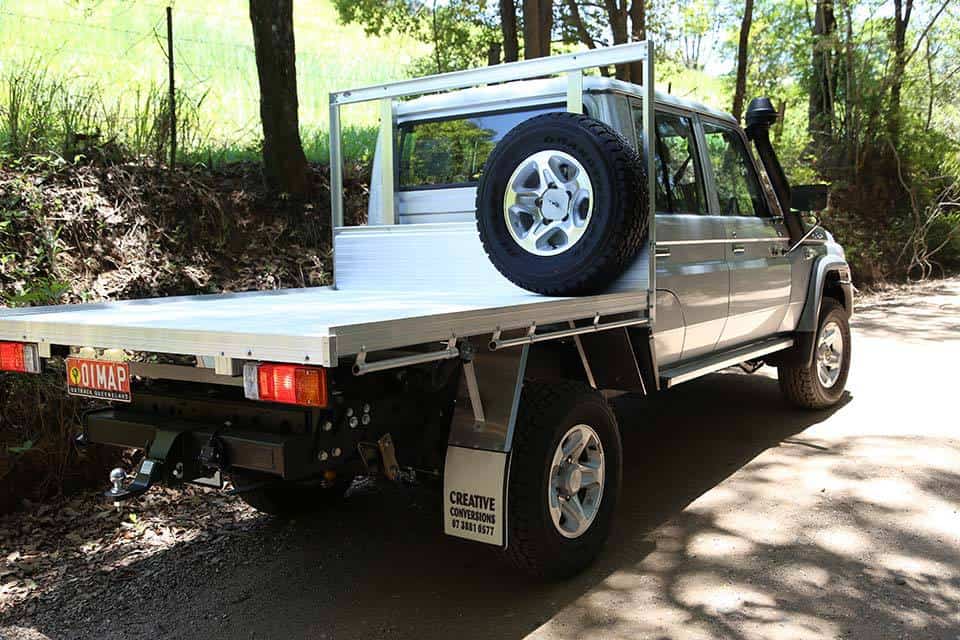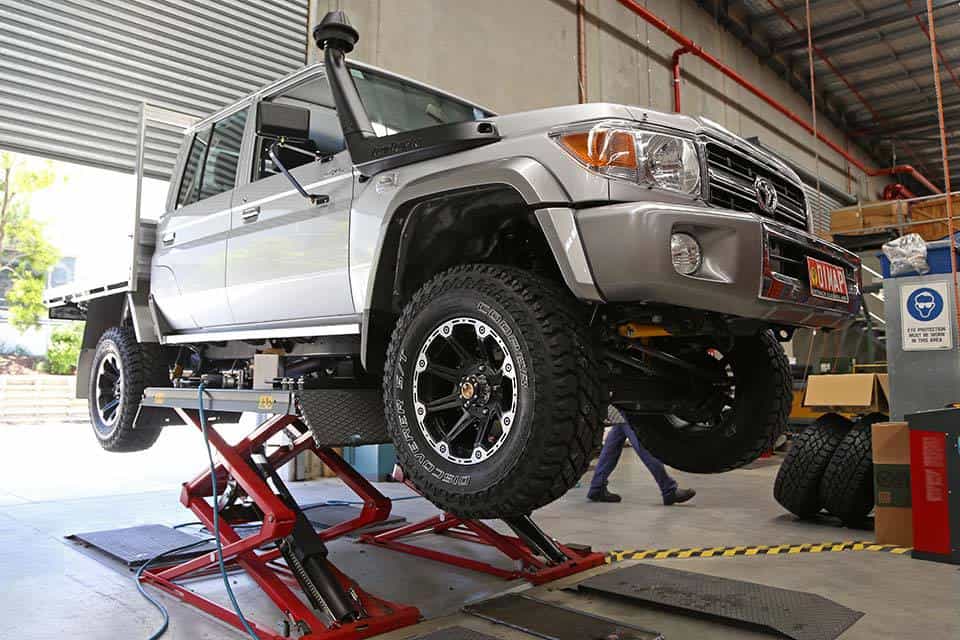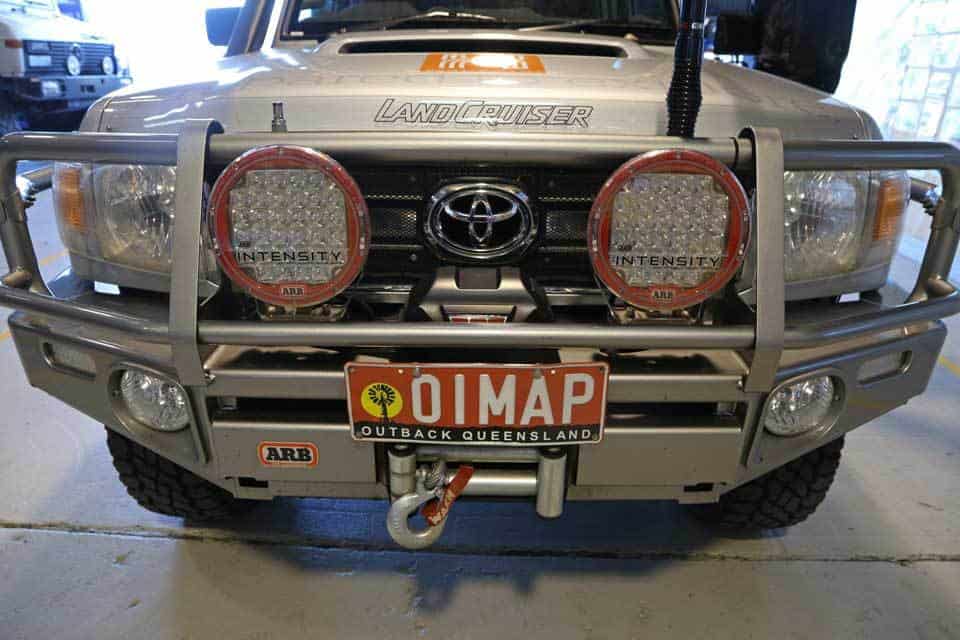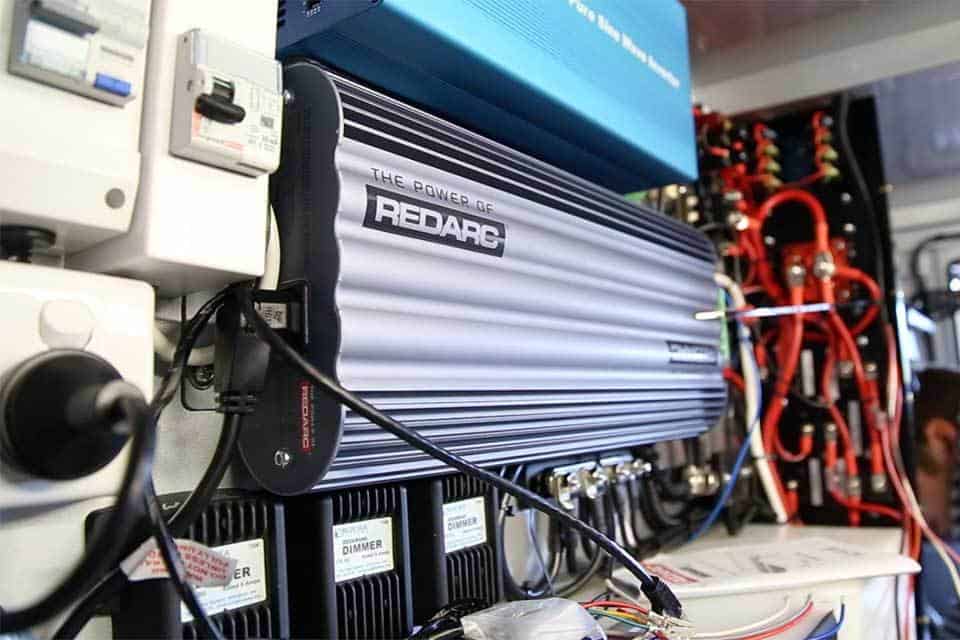Most four-wheel drives are built as a hobby with love, sweat, and loads of spare time. They are used by individuals to escape the city on weekends, explore new parts of the world, and even support other interests like kayking or rock climbing, but few of these trucks ever find their way into a company fleet. In general it’s too expensive and unnecessary for a business to invest in such a vehicle, but every now and then a company budget aligns with back country needs, and a purpose built four-wheel drive is born. While they rarely make a practical off-roader for normal enthusiasts, they are almost always awesome. It was these rare circumstances that led Hema Maps to build “Australia’s toughest mapping vehicle”, a dual cab 79 Series Land Cruiser loaded with some serious kit.
After using Nissan Patrols for 17 years, the Land Cruiser marked a serious departure for the company, but a necessary one due to Nissan’s recent changes in engines and design.
The cruiser’s more powerful 4.5L turbo-diesel engine, widely available modifications, and simplicity and durability helped to make it an easy choice for the team. Of course their needs far exceeded the truck’s stock capabilities, so they combined their 20 years of map patrol experience and called up a few experts to begin the build. The first step was strengthening the vehicle to handle heavy payloads. For this Hema turned to Creative Conversions, who reinforced the chassis and then extended it by 200mm. An Old Man Emu BP51 suspension was then installed, and the stock track width was remedied with a Multidrive Tru Tracker bolt-on kit. For those who aren’t familiar with this model of truck, there is 100mm of difference between the front and rear track widths from the factory, which poses a big problem in off-road conditions.
Finally, Hema installed a set of Cooper Discoverer ST Maxxs, a critical addition for the deep sand and sharp rocks found all over Australia. Their team has been running Coopers for nearly 20 years, and even after countless trips through the outback they only have good things to say.
When operating for extended periods of time in remote locations, it is vital to be self sufficient, which means improving capability, recovery options, and protection. Thankfully these are ARB 4×4’s areas of expertise, so Hema handed them the keys and things became very interesting.
We like to joke that everything in Australia wants to kill you, but it seems that this beautiful country is just as apt to kill vehicles as it is people. From kangaroo impacts to radiators clogged with bugs, there are plenty of perils beyond big rocks and deep mud in the bush, and Hema wanted to prepare for all of them. They began in the front with a color matched ARB deluxe bull bar to protect against large impacts and kangaroo strikes. The shape of the bumper not only improves clearance, but deflects animals down and to the sides for driver and passenger protection. They then added a pair of ARB intensity lights and optional fog lamps to improve visibility and minimize the chances of having to use their new bumper for its intended purpose… bumping.
Steel side rails and steps were also installed on the cruiser for additional protection and utility. These accessories, which are less common in North America, protect the rocker panels from flying debris on fast dirt tracks, rocks in technical terrain, and push aside brush on overgrown tracks. They’re also handy for adverse recovery situations and make the vehicle easier to access for those of shorter stature.
Of course the devil is in the details, and sometime it’s the small things that cause the biggest problems. Bugs, branches, and grass tend to get swept into the radiators of trucks crossing the outback, which can lead to overheating and even fires if left unchecked. A simple mesh guard over the grill can make quick work of such pests, blocking out any unwanted additions while retaining ventilation.
With the heavy dust and frequent water crossing encountered by the map patrol, a Safari Snorkel was an obvious choice. Diff breathers were also added to prevent the rapid cooling from drawing water into the drive line during fording.
Even the best drivers in the most capable vehicles can get stuck, and when you’re driving solo hundreds of miles from home, help will not be quick or cheap. To keep this Land Cruiser on the move a 12,000 lb Warn winch and steel cable was tucked neatly into the front bumper, and a full array of recovery equipment was secured including a snatch strap, winch extension strap, snatch block and other necessary gear like rated bow shackles, gloves, tree trunk protectors and a recovery damper.
Unlike most of us enthusiast who carry a camera and a few electronics along, the Map Patrol teams must be equipped with a large array of complex and sometimes delicate equipment. Unfortunately that doesn’t mix well with the rough and tough nature of the Australian outback, so a custom canopy and electronics system were in order.
A solution was found in Metalink, an Australian company that produces custom and production ute canopies from aluminum. Their goal was to design an enclosure to serve as a storage space, kitchen, and work area, while simultaneously accommodating an auxiliary battery and power management system, a fridge, water extra fuel, data storage array, and multiple charging stations for mapping and camera equipment. That’s no small feat, but they made it happen in a way that even lets the crew reorganize it all quickly and easily in the field.


The core of the shell design is constructed from high quality aluminum including the framing, skin, shelving, and drawers, while the design was kept simple for additional weight savings. This allowed the required equipment to be mounted without exceeding the Cruiser’s payload capacity.
A massive 90L water tank was mounted against the front wall of the canopy to serve as the vehicle’s main reserve during long expeditions, which under normal conditions will support a crew of two for over 13 days. Behind that a divider splits the shell into two sides: the left for the kitchen, and the right for a shared workstation and storage space.
The other side of the canopy was kept simple, an open space for jerry cans, swag tents, and personal gear. It’s amazing how often an oddly shaped piece of equipment will need to come along, and spaces like this are the perfect hideout for those occasional misfits. Underneath the entire storage tray are two drawers for more permanent items. This includes tools, gear, tripods, cameras, and other field equipment. Additional space for tools and an air compressor are positioned on both sides behind the fenders, and even the small unused area between the left drawer and rear of the canopy was utilized to hold fluids under a false floor panel. As a finishing touch Hema added a Fox Wing 270 awning for protection from weather and sun exposure on the road.
Despite how capable this truck had become, the final transformation into the Map Patrol had yet to occur. For this to happen a final step was needed, installation of the electronics. It is the advanced GPS and electrical systems that enable Hema to record off-road tracks with pin point accuracy around the world, and to do so reliably, they need everything built to the highest standards. Enter Global Sat out of Queensland, electronics and satellite experts specializing in back country applications for civilians and government contracts alike.
The auxiliary power system is based on two 150 amp-hour lithium ion phosphate batteries which are positioned at the front of the canopy near the water tank. When combined with the Land Cruiser’s charging abilities on the road or deploy-able solar panels, they can contentiously support a team’s electronic needs for weeks at a time.
A Red Arc Manager 30 controls the charge, while simultaneously displaying helpful information like volts in the batteries and remaining charge in days or hours through remote displays around the vehicle. This power management unit also includes an isolation function, which can cut off a battery for starting purposes only in the event the system runs too low.
In the case of the electronics system, Hema’s technical experts said it best, so I have included their full description in the dark boxes below.
“The LandCruiser’s impressive battery management system is a reflection of its power needs, which includes countless devices and hardware that are integral to our data collection process. All told, there are 47 circuits carrying power from the system, each one responsible for an individual task. Each circuit uses marine grade cabling to guard against water and dust ingress, and all are individually fused and colour-coded. In practical terms, this means that when a fuse blows, it only cuts power to that specific load without affecting the rest of the system. This enables our team to remain operational in the midst of an electrical fault, while allowing them to find the source of any problem instantly. This careful segmentation ruggedizes the entire system, and is indicative of just how much equipment GlobalSat has installed in the LandCruiser.
Starting with the driver’s side of the canopy, GlobalSat have created a dedicated charging bay for video and still cameras, laptops and other devices while not on the move, as well as to charge up power tools such as a drill if required. All 240-volt items in the canopy will take their charge from a 1000-watt inverter, which is hidden behind the custom panel that houses the main power management system, and is protected by an RCD and MEN link for extra safety compliance. The charging bay is complete with DC power through 16 USB ports at 2 amp-hour each, AC power from two power boards, and two mounted chargers for powering DSLR camera batteries. On the kitchen side is the Engel 80L upright fridge and switches for the air compressor and vehicle lighting, along with dimmers for the canopy’s interior lighting. Speaking of lighting, GlobalSat have installed two rear LED work lights, two side work lights and two light bars around the exterior of the LandCruiser, giving our expedition team the ability to turn night into day either on the road or at camp.”


“Moving into the cabin where most of the hardware was installed, the difference between a normal tourer and a Map Patrol becomes most apparent. Against the back wall is a 300-watt inverter to power 240-volt equipment in the cab, which will be primarily for mobile phones, tablets and navigation gear while the expedition team is on the move. In the front, starting on the driver’s side are gauges to monitor boost, EGT, water temperature, voltage of both the start and auxiliary batteries, as well as full amperage capacity of the vehicle at any one time. Below the gauges are a host of switches to give the driver immediate control over a variety of electrical functions: one to link the under-bonnet auxiliary and starter batteries, one for the LED driving lights, and another to switch between the vehicle-mounted and Patriot camper trailer reversing cameras for when the LandCruiser is towing. Also for towing is a dial to use the Redarc Tow-Pro electric trailer brake controller.
On the opposite side of the steering wheel is a low coolant alarm as well as an alarm for the canopy doors, which both sit underneath the Havis dock that houses the Map Patrol’s Panasonic Toughpad. The Toughpad is what our expedition team uses to capture mapping data, which is intermittently backed up to a hard drive mounted in the glove box. Below the Havis is a docked Iridium satellite phone, along with a dock for the Map Patrol’s dedicated smartphone. Both the satellite phone and the smartphone docks are linked to separate antennas mounted on the roof of the LandCruiser, which boost each phone’s signal in remote areas. Also on the roof is a differential GPS aerial that’s linked to the Toughpad, with the aerial mounted in the exact centre of the roof to optimise its half-metre accuracy that makes every Hema map so precise.”


“While the differential GPS aerial is on the roof, the receiver is inside the cabin, tucked away behind a Department of the Interior custom made roof console that also houses the Map Patrol’s UHF radio. The roof console also three dual USB sockets has switches for the LandCruiser’s external work lights, and in-built map lights for the front and a small LED for the back seats. Finally, in front of the roof console is an ARB reversing camera monitor, which can be switched between the vehicle and camper trailer cameras depending if the LandCruiser is towing or not. A Department of the Interior floor console with drink holders and an additional three USB sockets finishes the cabin transformatio
For most people this magnificent mapper is admittedly overbuilt. Its advanced systems and add-ons are too complex and unnecessary for ordinary needs, and its cost I’m sure was extravagant, but that is part of what makes it so darn cool. It is a dream machine, and the questions of if it is practical, affordable, or even attainable are moot. At the end of the day only question matters, can it do its job, and Hema answers with a resounding yes.
























